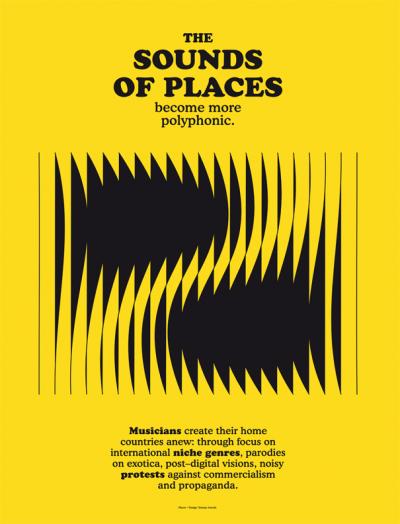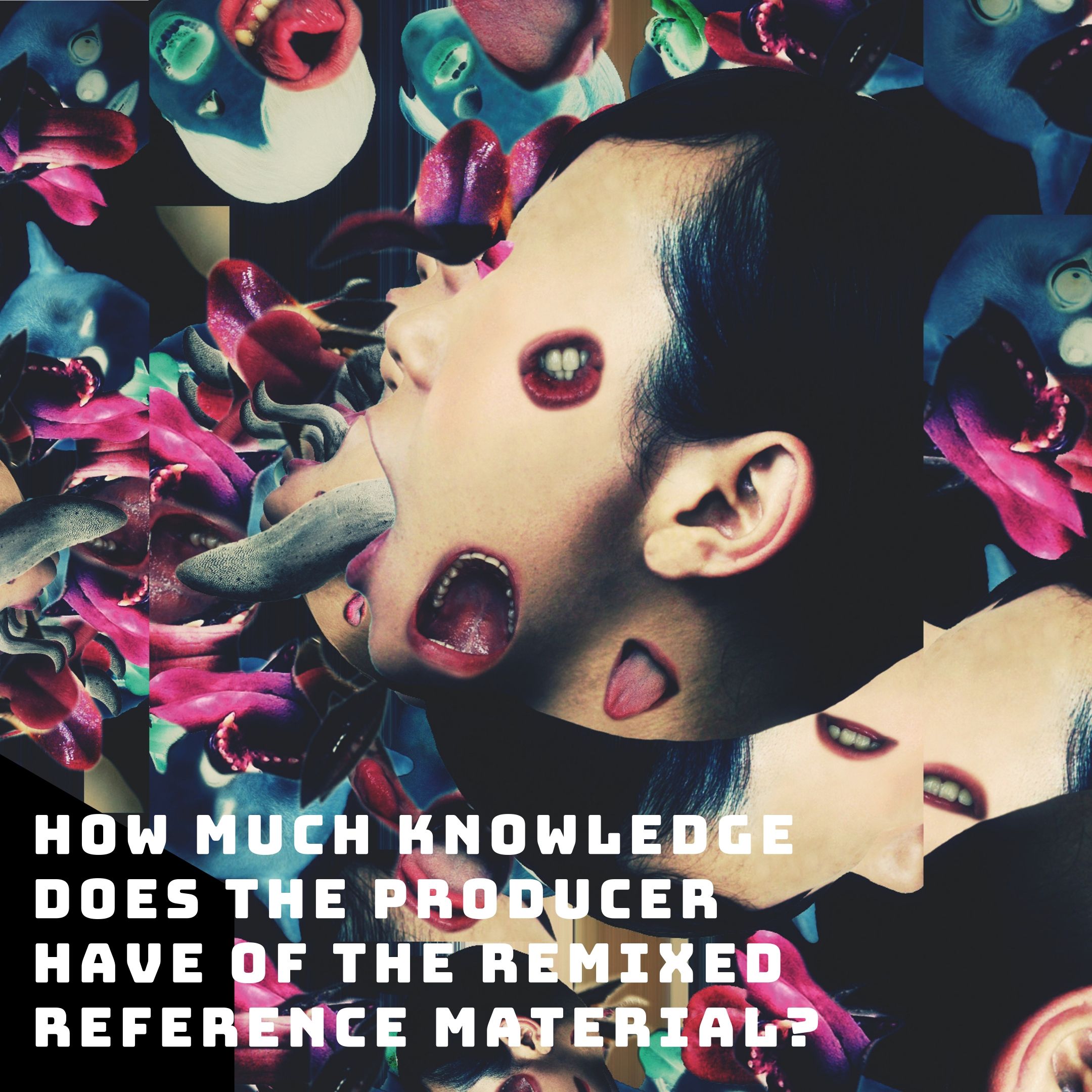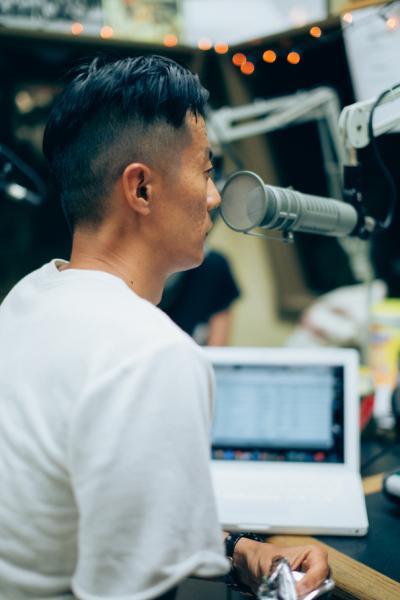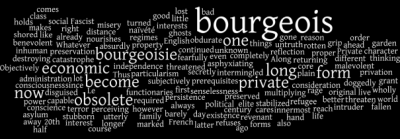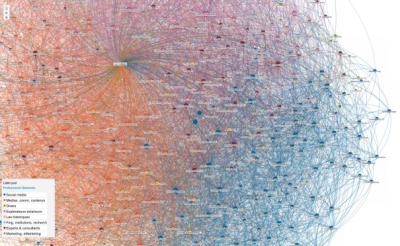Just like words to create sentences, songs and artworks have become building blocks for new ones. In his essay, Eduardo Navas proposes a future in which constant updates and connectivity will become ubiquitous. A shorter version of this article was published in the Norient book Seismographic Sounds (see and order here).
Introduction
Cultural production has entered a stage in which archived digital material can potentially be used at will; just like people combine words to create sentences (just like this sentence is written with a word-processing application), in contemporary times, people with the use of digital tools are able to create unique works made with splices of other pre-recorded materials, with the ubiquitous action of cut/copy & paste, and output them at an ever-increasing speed. This is possible because what is digitally produced in art and music, for instance, once it becomes part of an archive, particularly a database, begins to function more like building blocks, optimized to be combined infinitely. This state of affairs is actually at play in all areas of culture, and consequently is redefining the way we perceive the world and how we function as part of it. The implications of this in terms of how we think of creativity and its relation to the industry built around authorship are important to consider for a concrete understanding of the type of global culture we are becoming.
In what follows, I evaluate situations and social variables that are important for a critical reflection on how elements flow and are assembled according to diverse needs for expression of ideas and informational exchange. I begin by elaborating on what I previously defined as the regenerative remix (Navas 2012, 101–108), which is specific to the time of networked media, to then relate it to speech in terms of sound and textual communication. I then provide examples that make evident the future trends already manifested in our times.
Because digital media consists in large part in optimizing the manipulation of experience-based material that before mechanical reproduction went unrecorded, the aim of this analysis, in effect, is to evaluate how ephemerality is redefined when image, sound, and text are digitally produced and reproduced, and efficiently archived in databases in order to be used for diverse purposes. In other words, what happens when what in the past was only ephemeral is turned into an immaterial exchangeable element, and most often than not some type of commodity? To begin in what follows I analyze how the regenerative remix functions as a type of bridge to a future in which constant updates and pervasive connectivity will become ubiquitous in all aspects of life.
The Regenerative Remix
The regenerative remix did not exist prior to the time of new media – although the principles that inform it in terms of symbolic language certainly did. It developed as part of computer technology and our increasing ability to archive and reuse material as we see fit. The regenerative remix throughout the early 2000s was most evident in the Web application mashup – a specific type of software mashup, which juxtaposes two or more applications that are constantly updated, meaning that it is designed to change according to data flow. Early software mashups consisted of textual information overlapped with maps.
Google continues to implement this principle to produce many of its online services, which would quickly become irrelevant if the information on the respective applications forming the mashup were not constantly updated. In this sense, the regenerative remix mirrors the flow of constant cultural production which has consistently helped shape the general understanding of history. At the time of this writing mashups are also integral to the development of apps increasingly used in mobile media. This tendency however is becoming ubiquitous in all media due to the pervasiveness of networked communication; arguably, at some point in the future, it may be present in all aspects of daily life.
Image, Sound and Text
Unlike other types of remixes, the regenerative remix does not always have a specific form; instead, it comes about when an element is recycled in a way that is measurable. This means that the source being repurposed is available in digital form. If its original form was analog then it goes through a process of digitalization in order to be properly measured; or meta-data on the subject is inputted for proper analysis. This is relevant for image, sound, text, or any combination of the three. The regenerative remix is completely dependent on archives designed to be accessed recursively. Social media fully depends on principles of the regenerative remix, but social media platforms are not necessarily software mashups; rather they implement software mashup principles when APIs are used or accessed to create a feed into or out of their platforms (Navas 2012, 101–108).
Thus, social media can be considered part of the regenerative remix in terms of discourse. A person may notice or become aware of the originating sources that make up an element being used, but this awareness is not what validates such element as a cultural form. Instead, the cultural recognition of the source may be perceived as somewhat unimportant in the name of practicality – the validation of the regenerative remix lies in its functionality.
Software mashups are an obvious example of the regenerative remix because information constantly flows through them; the quantitative process of constant updating is an integral part of their functionality and validation (Navas 2012, 101–108). As it will become evident below, this is not so different from how speech constantly flows; but unlike oral communication, elements within the regenerative remix can be tracked and analyzed because such material is data that is archived. Speech unless it is recorded disappears into thin air. It must be noted that as recording devices are increasingly everywhere, there may well be a time when all activity will be recorded and uploaded to databases for automatized analysis. This stage may develop in the future as computer power grows and a market for tracking all activity, not just the consumption and behavior of humans, becomes relevant to ongoing investment in entrepreneurial innovation.
Regenerative Remix is Preceded by Older Types
The regenerative remix has its foundation in three other types of remixes, that preceded the time of the digital: the extended (popularized in disco culture when producers decided to make songs longer by extending the instrumental parts of tracks), the selective (explored by DJ producers who modified, deleted and added elements to create aesthetically different compositions of a pre-existing song which was recognizable as a type of version) and the reflexive (a meta-composition that allegorizes its source, much along the line of the selective remix; it may borrow from the extended remix as well in order to attain autonomy). All three types of remixes are found in music since the late 1970s and early 80s, and continue to play an important role in the production of new music genres.
The regenerative remix evolves out of the aforementioned meta-productions and borrows from them as needed to become pervasive in the flow of archived information in all forms as repurposed elements are released back into culture. Content can be produced anywhere and in any context. A person walking down any street, for instance, may notice something and decide to take a picture or video and immediately upload it to Facebook or Twitter; all of this in a matter of minutes, if not seconds. This opens the cultural space to major changes in how people come to relate to others in public.
The most evident example of this in the United States is reports of physical abuse of African Americans by (for the most part) white police officers. Video uploads documenting police interaction with African Americans are pivotal documentation in the growing number of reports. The arguments on this are contentious and are of major concern to the United States on national and civic contexts. In other parts of the world, the regenerative remix played a major role during the Arab Spring, particularly in Egypt and Tunisia, where activists on the streets used social media to self-organize against their respective governments.
It was also important for the Charlie Hebdo shooting in France, where social media once again was used to organize street walks in response to the deaths of cartoonists who satirized the prophet Muhammad, as well as to share images of people holding pens signifying the right to free speech; consequently, the hashtag «#JeSuisCharlie» went viral on Twitter for many days (Matrtinson 2011). People with divergent and conflictive goals can also make use of constant updates. Isis, the self-named «Islamic State» has been able to exercise its influence with the adoption of social media to spread their radical views, aiming to recruit people beyond the region of the Middle East (Gladstone and Goel 2015).
Constant Updating
In effect, people with all types of agendas come to shape the mediascape by uploading sound clips, videos, images or messages to any platform, whether it be social media, a personal website, or blog. Sharing media with a mobile device currently is as fast as writing a short e-mail or text to a person. Most recently it no longer is necessary to record to then send a file; one can now stream live while recording from mobile devices. In this respect, social media platforms used to perform all of these activities function more like a regenerative engine that can only stay relevant as long as people keep uploading and sharing material.
The current state of regeneration and recyclability is possible because we are at a point in time when we can communicate locally or globally with anyone, and experience content using a mobile device, while walking, riding a train, or flying on an airplane. Constant updating, the key principle of the regenerative remix makes all of this possible. Its foundation is in the flow of sharing ideas, which in the past were not always archived but simply shared in a social context, and perhaps recorded in some textual form byway of reconstruction of events. But once mechanical recording devices were introduced the ephemerality of events became more complex. It is to the implications behind the recording of the immaterial (of experience) becoming archived that we must now turn.
Regenerative Speech
The practicality in the regenerative remix is not so different from the way we use words when we speak. There is an awareness of this relation among scholars who write about remix culture, specifically in how remixing functions in similar fashion to creating meaning with language. What is important in this case is to understand the cultural implications of such relation, and how they formally appear to share an efficiency of production.
It is only prudent to revisit, granted at a very basic level, the basics of language acquisition. Before we are able to communicate effectively with oral language, we need to acquire (archive) a set of phonemes (basic sound units) - which in turn, when combined, become recognizable as words. All this information is kept in our memories, and eventually we learn to select and combine these building blocks in order to create sentences. We do this as we grow, while mimicking parents, members of our families, friends, and schoolmates. The oral acquisition of language, however, is eventually controlled by the act of writing, which turns it into an apparent static object, functioning more like a corpse to be studied carefully: one can go back to the written material as much as needed. Writing in effect becomes the elemental apparatus that anchors meaning once oral communication is perceived as an unstable way of sharing things that may have happened in the past or that are important for a community to function effectively. It is this apparent stability found in writing – the ability to record things with some type of technology – that led to the eventual development of other ways of recording the flow of cultural exchange, such as sound and images.
Sound is Viral
We can then agree that words function as basic building blocks for communication. Based on this premise, phonemes (basic units of a language put together to create meaning), do not belong to a specific person, and are not considered property in any practical sense. Part of the reason behind this is that phonemes travel as sound waves that reverberate through space, and humans, as is commonly known, sense the vibrations and bring together the message in their minds. In the past, sound would only be heard, but could not be preserved for later access until the phonograph and similar devices were invented in the second half of the nineteenth century. It was beginning around this time that the recording of sound could be considered as a type of immaterial object, which eventually would be reconfigured as a commodity once the entertainment industry emerged.
This turned out to be a process of control. The process of recording sound in a sense is driven by the human interest to domesticate noise. Indeed, humans strive to domesticate everything around them, including the environment, plants, animals and viruses. And it is with viruses with which humans appear to keep a contentious relationship. Sound, in its ephemeral form is viral. Sound and viruses can move in all directions, and keep challenging human control: viruses biologically, and sound culturally. These are the counter parts of resistance that push humans to evaluate their surroundings from a de-centered position, not from the view of the individual, but from the view of all things flowing, all things becoming.
Cultural Antibiotics
Mechanical, electronic, and eventually digital recording are cultural antibiotics created by humans to control sound which otherwise would be noise in a domesticated environment. In effect, recording devices are designed to help us negotiate and control sound based on similar principles used to control viruses. In both cases, humans are not always successful in having complete control, and outbreaks do take place both biologically and culturally. Coincidentally, the Ebola outbreak took place while Isis became pervasive across the media with decapitations of international journalists. Isis as an ideology making use of online media, however, appears to have outlasted Ebola, as the latter is now almost under control in Liberia and other parts of Africa (Fink 2015). Sound that is considered noise might well be the more difficult of the two to control – and once we implement the aesthetics of sound to media at large, once media strives to flow in all directions, it appears to function more like a type of virus people then struggle to control or, if seen as a threat, eradicate. It’s no coincidence that the term «viral» is used whenever something reaches a large circulation across the Internet.
Writing is our earliest and, in terms of economics, most efficient form of recording and control of language (due to its relative easiness to produce). With writing, an uttered statement deemed ephemeral, and therefore unstable, can be evaluated based on a set of symbols we call letters, which create words, phrases, sentences, paragraphs, chapters, books, and eventually libraries. The sequence of this development, especially the last two stages took hundreds of years; and libraries are now turning into digital archives. This was possible in part due to the concept of property. Intellectual property became crucial to the publishing and production of not only books, but also of music and the arts at large. Anything that would be produced with mechanical reproduction, which eventually turned into electronic and digital reproduction, has by default, at this point, a contention with copyright laws that remain unresolved. Thus, the aesthetics of sound, in term of the potential for free-flow which has been passed on to media at large, becomes a challenge to the control of property under capitalism. In short, while it is now accepted that we have always functioned as people who generate and regenerate meaning, what is different at the time of this writing as opposed to previous periods (particularly those before the rise of mechanical reproduction), is that we function under a pervasive concept of intellectual ownership. In contemporary times, things archived become property or negotiated under such paradigm in some way.
Intellectual Ownership
The word as a building block of communication, then, once it is anchored in the written text leads to a state in which a person has to evaluate constantly what is «original», because we come to view the composition of words in terms of writing as unique. It is with the combination of words that property becomes a form of intellectual dispute. The question is at what point does it become contested? At what point does a combination of words become someone’s property? How far does one have to go in terms of combinations before someone says that you are taking an excerpt from a text they wrote without proper permission? As noted above, elements in an archive currently function more like words in our memories. This may be a challenge to accept or even understand in part because it goes against the myth of a creative person being able to make things from apparently nothing. Economic factors also shape this myth because the concept of authorship turned out to be the foundation of creativity as generally understood. Such a concept in effect has influenced all forms of production, from scientific innovation to creativity in the fine arts – to this day, the author is still seen as important for validation of a work. The challenge in remix as a concept linked to this well established cultural paradigm is that the evaluation of sampling, and remixing from previous states of cultural production is continuously changing, and indeed we are entering, or arguably have already entered a stage where data, information, material in databases, whether they be video, sound, text or a combination of all types of media are developing a relation with us more like the use of words. We can then think of each pre-existing source as notes on a piano, ready to be played at the touch of one’s fingers. This argument is not speculative. How this functions can now be assessed in the common use of online search engines.
Regenerative Search
To understand at what point a basic element may be composed into something that would be deemed «original», we must consider how we agree that we share basic building blocks in all forms which we then customize for a specific individual vision. Our focus so far has been words; and for this particular form Google’s basic search feature can be implemented to show how words and phrases are in fact building blocks, which once they become part of an archive can function as samples. One can perform text searches on parts of a composition in order to see if the results at the top correspond directly with the text source. If this happens than we can consider the phrase a sample: a specific combination of words created by a specific person, and part of a specific text. Given that the phrases are formed of pre-existing elements then what we are dealing with at this point is really a unique set of combined basic elements, which in turn are created with smaller units (words, and letters). We need a case study to see how this works.
We could take any text that is available on the Web. But it serves best to take a well-known work, or a work that is considered unique in the way it was written. Literary works such as Ulysses by James Joyce, Moby Dick by Herman Melville, Beloved by Toni Morrison, or The Invisible Man by Ralph Ellison can all be found online, and are promising case studies due to the fact that they have been analyzed by many scholars, and taught in numerous classes. For this essay, I will share part of my ongoing research on a book that is not as widely taught as those mentioned, but was just as carefully written, and available will serve well as a good case study to understand how we may come to consider something to be produced specifically by a single person who in turn may claim it as intellectual property.
153 Aphorisms
I have been doing extensive analysis of Theodor Adorno’s book Minima Moralia (Adorno 2005), which consists of 153 aphorisms on all things relevant to living in a world that is increasingly mediated and commodified. I decided to analyze Adorno’s book for multiple reasons. First, I wanted to see if and how his apparently extreme criticism of culture, society, and media may still be relevant in a time of networked production. Another reason, which is directly relevant to this essay, is that due to his persistent critical position on what he considered mindless repetition, it is worthwhile to see if what he professed in theory was part of his actual writing practice (Navas 2015a). For the argument on sampling that I am proposing here, Adorno’s analysis is relevant in terms of how unique his sentence constructions may be. To evaluate this, I search on Google phrases, parts of phrases, or single words, devoid of any punctuation. I record them as part of a blog entry with corresponding links that provide the results. The reader can click on any of the links and be taken to respective search results, which will change according to Google’s updates on its search engine (Navas 2015b).
What the linking of phrases or words for entries of Minima Moralia makes evident is how we come to develop what we may consider original content. When I input a complete sentence into Google, Adorno’s publication appears at the top of the search, which means that Google is able to recognize the string of terms as a direct «sample» of Adorno’s writing. For this reason I break down each sentence into sequences that give the most diverse results that do not lead directly to Adorno. What becomes evident in this process is how we develop individual work that may appear «original» from pre-existing elements.
A single word search is likely to provide the most diverse result on Google with a dictionary definition of the word at the top of the page, which as we know is our basic building block in terms of composing phrases and actual sentences. What becomes apparent in this analysis is that the more specific the string of words, the more likely one is to reach a specific «sample» that may be deemed the original work of a particular person. This research, in effect, exposes not only how we create meaning, but also how we come to claim it as specific to a particular author. It is always based on the recognition of patterns; this is also applicable to all media, not just writing. Corporations who scan YouTube for infringement of copyright use a similar process for video and audio.
When Data Become Intensities
In effect, the text-mining of Minima Moralia exposes that what we tend to recognize as someone’s creation in any media is really a specific combination of elements that are mashed together by producers according to what they want to communicate, or express. In other words, when we speak, we are basically accessing and using a set of samples (phonemes/words) archived in a database we carry, called our «memory». Such combinations are presented and accepted as «property» when they are placed in a format that is considered more static (writing), which we then treat as an object (a corpse) we can go back to and re-read as needed, as long as we accept the premise that the word arrangement will not change. In the end, this is an ideology, as by now we know that even when a text can be considered static, it is not the same due to the process of interpretation performed by the reader.
Just like words are the building blocks of a written text, musical notes are the basic building blocks of music. Digital material such as videos, still images and texts uploaded to websites, blogs, databases and social media platforms online become the building blocks of contemporary global communication. Just like we can separate a written text into multiple pieces, from a book, to chapters, to paragraphs to sentences, to phrases, to words, to syllables and to each letter composing the written composition, digital technology similarly enables us to take apart any digitally produced work, to then repurpose segments as we see fit.
With computer technology, data becomes intensities; data becomes a type of informational vector that can be implemented as desired or needed. With the speed of network communication the perception of things being static is coming to an end, and the ever-changing state of forms produced (viral memes on YouTube and social media are an early example of this) will become valued more than a single instance of production; if technology keeps moving as it currently is, we may be able to view along with any regenerated object its history, as well as a prognostication of where it may be going. In short, nothing is original, just unique to the moment in which it is experienced.
Regenerative Knowledge
Knowledge has always been defined by flow and exchange of ideas and their application to specific criteria in which an individual or a collective is invested. But the difference with the current state of affairs is that as opposed to prior periods of history, knowledge is becoming fully quantifiable. The fact that we can assess how a phrase may be generic or specific by using Google for search attests to this. Tools are being developed that enable analysis of all types of activities and in effect measure them as they flow in real-time for specific goals that in the past would have relied upon pure speculation. Future-trending may be the most obvious example of using the quantification of knowledge in order to forecast what a company could sell with certainty in the future. Cultural theorists in contrast can use the same tools for the purpose of understanding how knowledge is produced. As noted in the introduction, we sample at this point as fast as we write words using a computer keyboard. With the computer we sample image, sound, and text using the same basic action of cut/copy & paste, essentially manipulating data. Thus we speak with samples (phonemes). In media we communicate with samples (digital recordings in all formats).
We can now go back to the regenerative remix to reiterate that it is most evident in software mashups; however, it is most potent when it functions as a binder of recycled material, which can only be of value when it continues to circulate. While circulation of ideas and the forms they take have been in evolving since we developed symbolic language, which in essence is regeneration (reconfiguration of material for new purposes), it is only in the time of computers and networks that all circulation, all flows are being recorded and data-mined. All this said, it is important to understand that to sample does not automatically mean that one is creating a concrete remix (as in a music remix – meaning, an aesthetic object), but rather contextualizing the samples to express a new idea, as previously noted. A remix as an actual aesthetic and deliberate production is a specific composition created with an emphasis on the fact that the material that is recycled and repurposed is pre-existing. One could sample from any song and use that sample to create a new composition, just like we can reuse a word in a new statement to make a different point in a different argument. This is how sampling functioned in early rap. «Rapper’s Delight» is not a remix of «Good Times» by Chic (although many people consider it as such).
It uses a bass line that allegorizes the song by Chic which the producers at the time it was released likely hoped would be recognizable by the listener and thereby potentially be a means to make the song more appealing and consequently popular.
Jamaican dub recordings, also known as versions, which preceded and informed the extended, selective, and reflexive remixes actually laid the foundational aesthetics of remix as a recognizable form in music.
Remix could be thought of as a specific aesthetic form. Much how poetry uses words to present an aesthetic, a remixed work takes any building block (image, sound, text) and enhances them to emphasize remix as an aesthetic. At the same time, remix is not bound to a specific form or medium, and for this reason, it also does not fully fit a concrete paradigm. Once it moves beyond music, it can flow in and out of all creative and practical fields. Having made this distinction, the regeneration that takes place across culture can be considered a regenerative remix (even when the product may not have been deliberately produced to be recognized primarily as a remix, aesthetically speaking) due to the transparent ways in which things are becoming repurposed across the network, while being archived as samples. The software mashup here again serves as an example because it is likely to be recognized for what it can be practically used, not for its aesthetic value (although one may notice this as well, but it is not its primary form of validation).
Social media pushes this further; in this case remix moves past specific forms to flow in all directions through social media platforms, based on constant updates. In effect, the world is turning into a giant recording studio in which people produce culture much how a DJ producer did in the early days of sampling as an act of postproduction to output remixed tracks. People are aware of the ongoing remixing of things, much how one may notice the aesthetics of a particular art form. Hence, the entire space of communication is overtaken by a type of regeneration that emphasizes remix as the aesthetic of daily production. In this sense, the regenerative remix cannot be assigned to specific forms, but can only be noticed when the act of constant updating based on archives and databases are at play for the sake of constant flow towards regeneration. It leans toward media virality – flowing wherever networked technology becomes pervasive.
Regenerative Labor
Sampling is the compression of compression. Sampling technology compresses the labor of producing in the studio. One does not have to play a melody, but sample it. Sampling turns the act of play – of performing – into a meta object that can be played as an instrument. This is why we can think of material in archives (in databases) as notes on a piano: one presses a key and sound is produced; one presses a button on a sampling machine and a sampled sequence plays; this is not so different from persons accessing their memories for phonemes to utter words which then become sentences that in turn become «samplable» if written as text, or recorded with a mechanical or digital device. In all these cases the elements stored are accessed to be compiled and to create a unique composition.
This shift puts the focus on selectivity as the crucial factor in the relation of labor and creativity. The increase in efficiency with emerging tools of compression consequently emphasize the selective process. In this sense, creative work that will hold the test of time may take just as long if not longer to produce, because in order for it to be unique enough to remain important, it must be a contribution based on in-depth knowledge of what has already been produced in the field, which may become a daunting task, considering the rate at which knowledge is increasingly produced. At the same time, it can be pushed formally in ways that were not conceivable in the past. This is now possible due to the ongoing development of new technology according to the vision of people who use tools and provide feedback. In an ideal situation, researchers may potentially develop more precise and rigorous results than ever before if they are able to analyze in-depth with proper use of research tools. This is promising but may not always be the case.
Regenerative Production
The regenerative remix at the time of this writing is more of a bridge to a state of default archiving of all regeneration. Just like new media was a term that now appears historically specific to a time of transition from analogue technology to digital technology, the regenerative remix in the future may be at best a historical precedent that was necessary to understand our transition to times when the flow of all forms becomes logged and archived. This in turns may mean that the ephemeral as previously understood will possibly become parallel in form and function with databases that enable what was superfluous in the past to be studied and reused for different future interests. The precision to data-mine and quantize then to archive the logs of such quantification will share the instability as well as the mathematical precision that enables the concept of innovation to be the privileged investment for both culture and capital.
The next stage is to produce without any lag, to produce as fast as we speak. There may well be a time not too distant in the future, when we may be able to access databases with image, sound, text, and video sources to express what we want just as fast as we utter a sentence. Allusions to this are already mythically proposed on television. During the month of April, 2015, a TV commercial aired advertising with the question «Can you deliver»? The ad is by Cognizant, a corporation which offers information technology services and data analysis. At one point, the TV spot shows a pair of headphones linked to a mobile device while the voice of a young person, states «can it download a song while I sample it»? The «it» in the sentence refers to the technology being used for the transfer and manipulation of data. The implied statement within the question is about speed and the ability to use all media as fast as one conceives of a possible use. It is therefore not farfetched to consider the possibility that, if technology is to move in the ever-increasing way it has thus far, we will leave our current speed of communication in the near future – for a speed that may be as fast as a person can think – and likely faster. What such forms may be is not clear at the moment, but technology is clearly invested in this type of innovation.
Remix as expressive as it can be, is also a specific way of framing and containing – of controlling things that at one point may have been transient. Performing a song live was once only ephemeral, but once it is recorded, it becomes an artifact, and potentially a commodity. This means that it is not just about understanding how we have been reinterpreting, appropriating – recycling ideas and knowledge since we developed symbolic language, but understanding how we must consciously engage with the implications of our ever-increasing control of language that becomes a way to exercise power at all levels of life – not just in the control of culture. The stability of regeneration as it becomes part of global networks has allowed humans to develop an industry based on the never-ending archiving of material under the influence of, and in contention with the concept of property. This evolved into an economy defined by an ever-increasing speed in production, and we may well reach a time when the instability of the archive may be, in part, in our inability to keep things stored properly for future generations, as well as our inability to see the potential in the flow of all things archived in terms of informational databases as means for ongoing production.
This is particularly difficult to fully comprehend because, while today we optimize all things produced so that they may be friendly to networked communication and exchange, there is instability in such production because, for the most part, it is enacted or overseen by «innovators» vested in capitalist interests that will not support the stability of an archive unless it proves lucrative. Another challenge may well be that archives, as they are now in place, may become more unstable because they will share (due to increasing speed of production), the apparent instability of speech; that is the archive’s foundational beginnings based on phonemes which the anchoring of writing first tried to control. The instability of archives, consequently, may be perceived as noise created by such speed. The challenge for the production of knowledge then may become what it already appears to be now: what and how to choose from the exponentially growing pool of sources to enhance one’s personal knowledge and thereby perhaps eventually contribute to the general knowledge which one accesses increasingly through databases, while critically understanding the implications of one’s contribution as a piece of data useful for the forecasting of trends.

